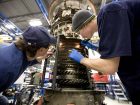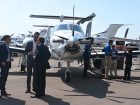
News
Staying up to speed
In early October, the honourable Navdeep Bains, minister of innovation, science and economic development, announced an investment boost of up to $54 million in a consortium of Canadian aerospace companies and academic institutions that will develop cutting-edge electric and advanced-aerodynamic systems.
November 3, 2016 By Matt Nicholls
 Business aviation offers real potential for aerospace growth in the future. In early October
Business aviation offers real potential for aerospace growth in the future. In early OctoberThe funding, to be delivered under the government’s Technology Demonstration Program, will be used to support collaborative research and early stage, large-scale projects that develop next-generation aerospace technology. The consortium is to be led by Bombardier Aerospace with partners Rolls-Royce, Thales, Microturbo (Safran), Liebherr, OPAL-RT, Quaternion Aerospace, FusiA, Axis, the University of Victoria, Ryerson University, the University of Toronto, McGill University, the National Research Council Canada and Polytechnique Montréal.
The aerospace infusion is the latest example to illustrate how committed the new Trudeau government is in ensuring Canada maintains – and enhances – its ranking as an aerospace leader on the international stage.
The federal government’s commitment to aerospace growth is not lost on Aerospace Industries Association of Canada (AIAC) president and CEO Jim Quick. In a wide-ranging interview with Wings just prior to this year’s 2016 AIAC Aerospace Summit on Nov. 15-16 in Ottawa, Quick shared his perspective on working with the new government in expanding Canada’s aerospace footprint, as well as a number of other key issues.
2016 was a challenging year for many aerospace companies in Canada, though some flourished. Can you give us your take on the year-to-date and outline what challenges – and solutions – companies are implementing to grow and innovate?
It was a challenging year for niché sectors such as business jets and helicopters. This hits hard from the standpoint that we are global leaders in these areas. We also had some companies and sectors do very well though, such as MRO and this helped offset the impact of the other companies that had challenging years. From an association perspective, we are happy with our progress. We had a state-of-the-industry report come out, a great Farnborough Airshow with a very strong presence from both government and industry, and ADSE in Abbotsford, B.C. was our best show ever. We also had a busy year in transitioning to a new government. We did a great job in developing an understanding of how the government wanted to work, how they wanted to work with us, and what is most important to them. I’m really excited about the innovation agenda and how the government will be focusing on this.
What is your impression of the new federal government and its commitment to Canadian aerospace?
I am impressed with what I have seen. It didn’t take them long to get up to speed on their agenda; they have engaged us early and often. They are focusing on their socioeconomic agenda and how we fit into that – and we have seen a lot of exciting progress in that realm.
The State of the Aerospace Industry 2016 Report released earlier this year did a great job of outlining the economic impact aerospace has both here and abroad. Can you comment on the impact the study has had?
It’s an initiative we started with Industry Canada (now Innovation, Science & Economic Development Canada) four years ago. We wanted to have aerospace data and analytics we could talk with – and to – industry and government about. This data helps us communicate to stakeholders and the public at large about how important our industry is – the economic and socioeconomic impact it has in terms of families, communities and jobs. It also highlights the impact aerospace has on the middle class, a significant priority for this government. It gives us key insights into what we need to do from a program and policy perspective.
Were there any surprises in the study?
It cemented what we’d already been thinking about in a few key areas for our industry, particularly in terms of innovation. It gave use new detail about how we compare to other manufacturing sectors. For example, we have five times the R&D that other sectors have. Our productivity growth has been 2.5 times greater than other sectors, 55 per cent higher in export intensity, and two times more diverse than the average manufacturing exports. We also learned a lot about how the jobs we create impact the overall Canadian innovation agenda. For example, some 30 per cent of our employees are directly involved in producing some type of innovation; in the space sector, this number grows to 60 per cent. Aerospace manufacturing accounts for close to 30 per cent of total manufacturing R&D. The other thing we learned is Canadian operations of foreign-owned firms contributed more than 40 per cent to Canada’s R&D investments. This tells us that foreign-owned companies are coming to Canada because they can conduct high-level R&D activities here and we welcome that.
Are there specific locations foreign firms are gravitating to?
It has been a diverse distribution geographically, which is a good thing. Province to province, we have an attractive investment environment. Having been to Farnborough, Paris and other major aviation shows where provincial ministers are in attendance supporting their industries . . . let me just say they are very competitive in letting foreign jurisdictions know how good their tax regimes are, their investment environments are etc. So it’s a pretty aggressive environment.
Is there a regional cohesiveness in helping to drive aerospace development in Canada?
We have developed a comprehensive national strategy around aerospace and defence. Progress is being made in the space sector as well. Our national objectives will only be successful if we are strong in the respective regions. We are trying to identify key capabilities that each specific region can take in terms of a leadership role; there are specific provinces that understand this, particularly B.C., Ontario and Quebec.
What aerospace sectors are experiencing the most growth and what opportunities do you foresee in the future? Are we doing enough in Canada from an R&D perspective?
Our global forecast from an aerospace perspective is very positive; such as the growth of the global fleet in the next 20 years. This represents some $5.9 trillion dollars in aerospace development. Our job at AIAC is to make sure we get as big a slice of this pie as possible – and the competition is fierce. I think innovation is one of our greatest competitive advantages. We have a long history of innovation and this is reflected in the growth of segments such as unmanned aerial systems (UASs). We’re also very focused on ensuring that there is strong support for both product innovation – that is making new and innovative products – to process innovation, which looks at ensuring that we’re being innovative in the way we manufacture, our manufacturing process. This is going to be very important as manufacturers move away from design to delivery, and hopefully will give us a competitive advantage. On the space side, it’s about downstream and how Canada takes advantage of downstream. There are also opportunities around advanced manufacturing. In terms of the supply chain, it’s all about how we prepare companies to scale the global supply chain.
ADSE in Abbotsbord, B.C. this fall was once again a success. What are your thoughts on the event – is it meeting expectations?
When we initially took over ADSE, it was running at a deficit and, now, it is back to where it needs to be from a program point of view. From a financial perspective, our member companies are supporting it well. This summer was very interesting as we had the F-35 and the Super Hornet at the event; it provided some added flair. We also announced we would be partnering with the Canadian Business Aviation Association (CBAA) to help grow next year’s event. Business aviation is a key part of our industry and we are global leaders in that sector, so it’s an exciting addition to the event. CBAA president and CEO Rudy Toering and his team have been working with ours to put together an even bigger and better show next year, and we’re looking forward to seeing ADSE continue to grow in the years to come.
Are the various levels of government engaged and empowered enough to understand the important role aerospace plays in Canada?
The new federal government has a different way of engaging that we are very supportive of. The engagement is extremely meaningful and constructive; it is very focused on how do we bring the industry to the next level. I like the idea of working around the concept of innovation – how do we use innovation to propel the industry to the next level from a global competitiveness perspective. Their teams are very knowledgeable and experienced. They understand our issues and are engaging with us pretty much on a daily basis about what the industry needs and wants. They want to make decisions and want to move the yardsticks. The government engagement on defence procurement is a good example. Ministers (Judy) Foote (Minister of Public Services and Procurement), Bains and (Harjit) Sajjan (Minister of Defence), have been engaged early and often in this process. It’s different than the types of face-to-face engagement that were used in the past, but it’s still effective. They are using social media and other tools to get their messages out. We’re still working with the government from an overall strategic perspective – and we’re using their chosen vehicles to do it.
The AIAC’s Aerospace Summit in November is always a strong event. Are you happy with the development of the event and what it has accomplished?
Our program this year is top notch. We have tried to focus on CEO-level speakers from Lockheed Martin, Bombardier, Bell, Boeing, MDA – all looking at how our world is changing and what we need to do to remain a leader in the industry. We will focus on innovation as well with the innovation agenda being front and centre this year. We will also hand out our annual James C. Floyd award for aerospace achievement and recognize the life and contributions of MacDonald Dettwiler executive vice president Dave Caddey, who passed away last year.
Let’s talk about the space part of aerospace. Are you pleased with the efforts being made in this realm? Is Canada where it needs to be?
When David Emerson unveiled his report in 2012 on the state of the Canadian aerospace industry, he noted that the Canadian space industry was at a crossroads. I still feel this way. I am pleased with the level of engagement we are getting from government in terms of recognizing there needs to be a long-term solution for Canada – but we need to determine what this path is. In addition to the critical long-term element, we also have an immediate need to make sure our industry remains competitive so we do not lose capacity and capability to other jurisdictions such as the U.K. We have a short-term need to keep capacity and capability here and develop a long-term space vision that is engaged at the highest levels of government.
What are the biggest challenges facing the Canadian aerospace industry heading into 2017? Possible solutions? Where do we need to be in the future?
From a manufacturing standpoint, the challenge is how do we continue to look at moving people from design to delivery; how do we grow Canadian companies from a supply chain perspective so that they can compete at a higher level in the global supply chain. On defence, we have one of the world’s best in-service support industries. What are we going to with the defence review and defence procurement to ensure we are building capacity and capability here in Canada? From a space perspective, we need to cross a short-term bridge to develop technological capability and keep that technology capability to get to a longer-term space vision. While the aerospace forecast is quite good over the next 10, 15, 20 years, we are still seeing some sectors with some issues – helicopters are an example. The good thing is we can see light at the end of the tunnel. We have a government that wants to support our industry, we just have to get to the point where we are talking specifically about what we are going to do. We also have a global industry that is growing, roughly five per cent a year, and that’s a great opportunity for us. We have $5.9 trillion of work out there that we have to get a piece of, so we need a sound strategy to do it.
You highlighted Canada’s leadership role in international MRO capabilities. Where do you see opportunities in the MRO space?
We have seen growth in the last couple of years in MRO and this is definitely a growing segment in western Canada. The government of B.C. is trying to ensure we remain a leader in this segment; we are seeing growth in Atlantic Canada. But while this is encouraging, the global competition in the MRO space is fierce. Jurisdictions such as Singapore and the UAE – their main focus in aerospace is MRO. They are doing this in an intentional manner. We know the competition is fierce and we need to up our game. Fortunately, there is a commitment from provincial and federal governments to grow the industry.
Anything else you would like to highlight and discuss? Is Jim Quick pleased with the progress being made?
The AIAC has certainly helped shape the national agenda. We have created a national strategy around how Canada remains a global aerospace leader, but we need to do a better job of establishing synergies with our organization and federal programs. We don’t have the luxury of throwing trillions of dollars worth of funding at programs, so we have to be nimble and smarter than other jurisdictions about how we use our money, how we prioritize the things we do. We need to establish technology demonstration programs and create national research and technology networks. These will create tremendous dividends. I am excited about what may come out of the innovation agenda and the defence review, so I think we are in a good place. We have to make sure industry and government are in sync with where we need to be focused and how we want to get there.



